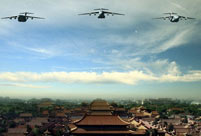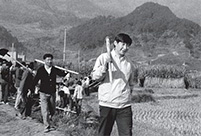 Top 100 beauties in the world!
Top 100 beauties in the world!
 Gallery: Who is the most beautiful one?
Gallery: Who is the most beautiful one?
 If you like autumn, put your hands in the air!
If you like autumn, put your hands in the air!
 Fan Bingbing's "Queen style" in new play
Fan Bingbing's "Queen style" in new play
 Lingerie show at 2014 Miss China
Lingerie show at 2014 Miss China
 J-10 fighters show aerobatic stunts in smog-free sky
J-10 fighters show aerobatic stunts in smog-free sky
 Charming contestants of Shanghai Int’l Model Contest
Charming contestants of Shanghai Int’l Model Contest
 Most amazing chi-pao beauties
Most amazing chi-pao beauties
 7 deadly animal attacks
Russia to launch 70 Proton rockets by 2020: official
7 deadly animal attacks
Russia to launch 70 Proton rockets by 2020: officialDuring the 6th World Park Congress in Australia, Madam Monique Barbut, Executive Secretary of UNCCD Secretariat, and Mr. Wang Wenbiao, the Chinese role model for desertification combating and COP 11 award-winner of “World Dry Land Champion” jointly release the initiative of “Mending degraded Land to Promote World Peace and Security”. It calls for an effective union to be set up by governments, international organizations, private enterprises, entrepreneurs, NGOs and the society, enhancing partnership for cooperation and dedicating to the global desertification combating for better eco-environment,alleviated poverty, world peace and security.
Mending degraded lands to promote the world peace and security
By Monique Barbut* and Wang Wenbiao**
We all seek peace and prosperity. The technology-dependent Millennialgeneration is setting a new trend in pursuing these goals. Youth consumption is driving economic growth in many developing countries and a large number of youth and children are becoming millionaires. But a large number of the Millennial is also pursuing peace and prosperity through a war economy, mostly out of desperation, not by design.
A vast majority of the rural youth in developing countries is poor and depends on land resources to create wealth. But as climate change takes a toll on degrading lands that are declining productivity, many young people are finding it more and more difficult to make a decent living. Disillusioned and unemployed, many are making the difficult choice of either fleeing their homes or joining a conflict economy that is offering pay for criminal or other extremist activities.
These challenges may be in distant lands like Afghanistan, Iraq, Pakistan, Somalia, Syria or Yemen. But they still eat into our own pursuit of peace and prosperity. The humanitarian and military interventions taken to contain the insecurity, political instability, forced migration and the like, come at a high price.Yet, China, Ethiopia and Niger areinnovating investment approaches on improving land deterioration that these and other poor developing countries with vast degrading lands can use to turn around people’s livelihoods and their economies.
Today, more than 1.5 billion people many of them poor,eke out a living from barren soils or desert areas. Poverty in this population group can be eliminated within a relatively short time. By restoring only 600,000 hectares of land in the Loess Plateau, for instance, China lifted 2.5 million poor people out of poverty. Household incomes climbed from an average US$70 to US$200. Grain production increased from 365 kg to 591 kg per person per year, on average. And all in less than two decades – about the same duration as the Millennium Development Goals.
There is a large amount of degrading land around the world. More than 2 billion hectares of land is degraded, and can be restored. About 500 million hectares of crop land is lying waste – abandoned completely. The actual, total project cost of restoring the Loess Plateau was US$491 million; an investment of about US$820 per hectare. At this cost, we can rehabilitate all the abandoned cropland at a cost of US$410 billion.
 |
 Female soldiers
Female soldiers Hot girls at motor show
Hot girls at motor show  Official trailer of Y-20
Official trailer of Y-20 Photos: Xi Jinping in Fujian
Photos: Xi Jinping in Fujian Standard faces for each countries
Standard faces for each countries China-made military transport aircraft gets ready
China-made military transport aircraft gets ready World Pole Dance Championship in China
World Pole Dance Championship in China Shocking! Photos of Chinese fighters revealed
Shocking! Photos of Chinese fighters revealed 59-year-old Liu Xiaoqing still looks stunning
59-year-old Liu Xiaoqing still looks stunning  Top 10 most dangerous jobs in the world
Top 10 most dangerous jobs in the world  Top 10 fifth generation jet fighters in the world
Top 10 fifth generation jet fighters in the world Top 10 Chinese goddesses
Top 10 Chinese goddesses  Top 20 hottest women in the world in 2014
Top 20 hottest women in the world in 2014 Top 10 pure beauties in showbiz
Top 10 pure beauties in showbiz  Top 10 world's highest-paid models 2014
Top 10 world's highest-paid models 2014 The most gorgeous Chinese women
The most gorgeous Chinese women Top 10 most handsome faces in Asia
Top 10 most handsome faces in AsiaDay|Week|Month